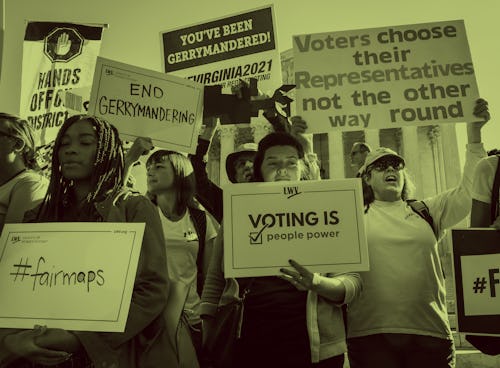Black and Latino populations are growing, but their voting power isn’t
Gerrymandering has given rise to more majority-white congressional districts.

The 2020 U.S. Census revealed that people of color are a growing part of America’s population, but a new report from The Washington Post shows those groups aren’t seeing an increase in their voting power. The reason: gerrymandering.
Here are the numbers from the 2020 Census and the current shape of congressional districts across the country, which are pretty difficult to square: According to the Census, the white population decreased by 8.6% (though it’s still the largest single race or ethnicity group in the country by far), while the Hispanic or Latino population grew 23% and the Black population grew 5.6% since 2010. Despite this, WaPo found that Black-majority districts have decreased by five seats and Latino-majority districts grew by just four seats in the most recent congressional maps, which will be in place for the 2022 midterms. By contrast, there are eight newly drawn white-majority districts.
The findings reveal the unaccounted effects of gerrymandering, a practice that is often viewed only through the lens of political affiliation. Gerrymandering occurs when lawmakers redraw the lines of the maps for congressional districts. In most states, the political party with legislative control in the statehouse gets to set the boundaries for each district. This often leads to wonkily drawn lines designed to capture specific voting blocs in order to strengthen the control of the party in power. The minority party is often left disenfranchised, with less representation — even when the party has more total voters, because those voters are lumped together in a way that minimizes their influence.
There were concerns that congressional districts created following the 2020 Census would be devastating to Democrats, because Republican-controlled states would get to make the majority of changes and could draw themselves a significant advantage for the upcoming midterm elections. But, per The Washington Post, those concerns haven’t come to fruition yet. While just 28 states have finalized their maps, Democrats have actually gained five favorable districts. Ironically, that appears to be because Republicans gerrymandered the maps so much in the past that they actually have fewer options for creating favorable districts now.
But while the political partisanship seems to have been minimized, racial disparities are growing. Voters of color are increasingly being drawn into single districts, concentrating their voting power in those locations while shrinking their overall impact on elections — and it means these voters are losing their say in their representation, even as their populations are growing.
This issue can be seen in action in Alabama. While nearly three in 10 residents are Black, a proposed map would have placed more than half of that population in a single district; as a result, six of the state’s seven total districts would be white-majority. That map was rightfully rejected by a panel of three federal judges. It will likely be appealed and may make its way to the Supreme Court, where the effect of gerrymandering on minority voters will finally be in the spotlight. Given the court’s current makeup, it’s probably not worth holding your breath for a positive result — but one can hope.